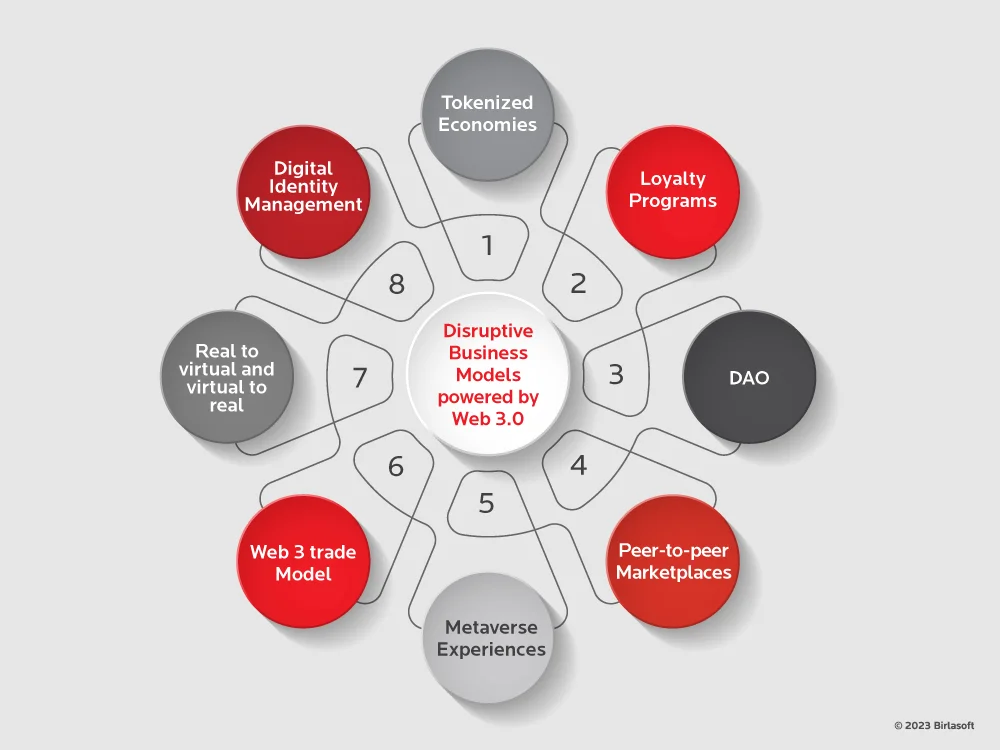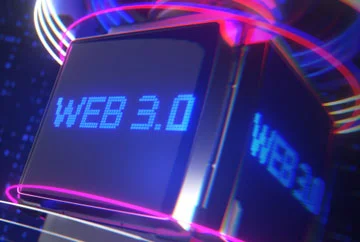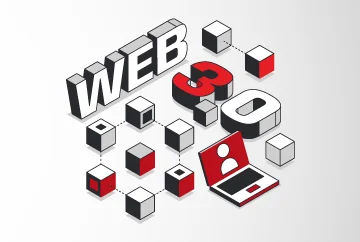In the dynamic digital realm, we have seen the rise of pivotal technologies that have reshaped the way we interact with the online world. A key milestone is Web 3.0, often termed the decentralized web, heralding disruptive business models across various sectors. It emphasizes enhanced user experiences, privacy, security and enables decentralized applications (dApps) and peer-to-peer interactions. Previously, we explored Web 3.0's key features in Web 3.0 - Striding towards the Internet of the Future. In this article, we will delve into how it is changing the dynamics of industries.
At its core, Web 3.0 is characterized by several key features that differentiate it from its predecessors. One of the fundamental aspects of Web 3.0 is decentralization, which shifts the power from central authorities to the users themselves. Blockchain technology plays a vital role in enabling this decentralization by providing a transparent and immutable ledger that eliminates the need for intermediaries in various processes. Smart contracts, self-executing contracts with the terms of the agreement directly written into code, facilitate secure and automated transactions, further enhancing the efficiency of Web 3.0 applications.
Now let's explore how Web 3.0 is transforming industries across sectors:
1. Finance & Banking: With the advent of Web 3.0, the financial landscape is witnessing a disruptive shift.
- Decentralized Finance (DeFi) platforms have emerged, allowing users to participate in various financial activities such as lending, borrowing, earning interest, and other banking and trading activities without the need for traditional intermediaries. Moreover, blockchain technology facilitates secure and fast stock or fund transfers, eliminating lengthy settlement times and slashing costs.
- Web 3.0 has the potential to improve the financial inclusion of underserved communities due to features such as decentralization and accessibility. This can help in creating an equitable financial system.
- Web 3.0, through blockchain, also transforms the lending process by eliminating intermediaries and instead depending on a smart contract to automatically pay out money to borrowers when specific terms are met. It also allows for managing the payment process while simultaneously ensuring that all terms are visible to all parties.
- Blockchain and smart contracts can also make it difficult for fraudsters to manipulate or tamper with data, reducing the risk of fraud in financial transactions.
2. Manufacturing and Supply Chain: Web 3.0 brings transparency and traceability to supply chains through blockchain-based solutions.
- By leveraging distributed ledgers, companies can seamlessly track and verify every step of the supply chain, ensuring identity verification, visibility, authenticity and quality of products. Ownership validation can be seamlessly enabled with digital signatures.
- Smart contracts can automate complex tasks such as ordering and shipping once specific conditions are met, streamlining processes and reducing delays.
- Blockchain technology allows for creating an immutable audit trail of all documentation.
- Digital twins are already transforming manufacturing processes by supporting decision-making, optimizing performance and enabling virtual commissioning
- Web 3.0 also has the potential to reduce the costs and effectively streamline product recall processes.
- Web 3.0 can help in improving stock reporting with the availability of real-time information and can also help in reducing intermediary costs.
3. Healthcare – Web 3.0 shows great potential in improving transparency and efficiency in healthcare.
- A key application of Web 3.0 in healthcare is that of transforming Electronic Health Records (EHRs). Patients have ownership of their data, the data is immutable and unauthorized usage of this data is minimized. Blockchain can also help in linking several siloed records to create a single record for a complete view of medical histories.
- Use of AR and VR in healthcare can help create immersive experiences and enhance collaboration in diagnosing and treating patients. This can range from virtual simulations for honing skills and planning complicated surgeries to surgeries with augmented reality. VR headsets have also proved to be effective for pain, stroke, PTSD management etc.
- Digital twins can allow for greater visibility and precision in the operating room, allowing surgeons to precisely perform complex procedures. They can also help in simulating disease progression and treatment methods.
- AI technologies can help in patient monitoring, creating tailored treatments and improve healthcare processes across functions.
- Tokenization and NFTs can help in verification, authentication and improve transparency in the healthcare space while protecting IP and patient data. NFTs can also help in creating novel monetization strategies.
4. Retail: The retail industry is undergoing a remarkable transformation with Web 3.0.
- Immersive Virtual Reality (VR) shopping experiences enable customers to browse virtual stores and make purchases from the comfort of their homes.
- Ultra-personalization algorithms leverage user data to provide tailored recommendations, enhancing the shopping experience.
- Seamless financial transactions powered by cryptocurrencies and digital collectibles are also becoming a reality, further blurring the lines between online and offline retail experiences.
- Additionally, co-creation platforms enable consumers to participate in the product design process, fostering a sense of ownership and engagement.
5. Science: Web 3.0 is reshaping the scientific landscape with the concept of Decentralized Science (DeSci).
- Researchers can collaborate in a trustless environment, sharing data and findings securely while maintaining ownership and attribution.
- Smart contracts ensure that scientific contributions are rewarded, incentivizing innovation, and accelerating scientific progress.
- Web 3.0 can help in the creation of peer-to-peer marketplaces for scientists where they can trade knowledge, services, and equipment access. This can facilitate research and co-operation.
6. Disruptive Business Models: Web 3.0 introduces a plethora of disruptive business models across industries.

- Peer-to-peer marketplaces: Web 3.0 enables the development of decentralized peer-to-peer marketplaces where buyers and sellers can directly interact and transact without intermediaries. These marketplaces leverage blockchain technology to provide transparency, security, and trust, empowering users to engage in frictionless and peer-driven commerce.
- Loyalty programs: With Web 3.0, loyalty programs can be tokenized, allowing users to earn loyalty points through digital tokens. These tokens can be seamlessly exchanged, transferred, and redeemed across participating merchants. Web 3.0 loyalty programs provide a more flexible and rewarding experience for customers fostering deeper engagement and brand loyalty.
- Metaverse experiences (across industries): Web 3.0 introduces the concept of the Metaverse, a virtual world where users can interact, create, and transact across industries. This immersive digital realm transcends individual sectors, offering unique experiences such as virtual events, virtual commerce, and virtual social interactions. Web 3.0 enables seamless integration of the physical and digital worlds, opening new possibilities for entertainment, education, and business.
- Web 3 trade model: Web 3.0 introduces a new trade model that facilitates real-to-virtual and virtual-to-real asset exchanges. Users can convert physical assets into digital representations, allowing for fractional ownership, increased liquidity, and enhanced accessibility. Additionally, virtual assets can be traded back into the real world, bridging the gap between physical and digital economies and unlocking new avenues for value creation.
- Real to virtual and virtual to real: Web 3.0 converts real-world assets, such as real estate or artwork, into digital representations through tokenization. This tokenization allows for easier fractional ownership, increased liquidity, and global accessibility to traditionally illiquid assets. Conversely, virtual assets and collectibles from the digital realm can be tokenized and exchanged for real-world value, blurring the boundaries between the physical and virtual worlds.
- Tokenized economies: Web 3.0 introduces tokenized economies where digital tokens act as units of value and can represent ownership rights, access to services or participation in decentralized networks. These tokenized economies create new business models, incentivize user engagement and contributions and enable novel forms of collaboration and governance within decentralized ecosystems.
- DAOs (Decentralized Autonomous Organizations): Web 3.0 enables the creation of Decentralized Autonomous Organizations (DAOs) that operate on blockchain technology. DAOs are self-governing entities, managed by smart contracts by their token holders. They enable transparent and community-driven decision-making, resource allocation, and coordination, fostering collective ownership, participation, and innovation.
- Digital identity management: Web 3.0 prioritizes user privacy, security, and data control. Through decentralized systems, individuals own their digital identities, selectively share information, and establish trust in online interactions. This reduces reliance on centralized authorities, enabling secure identity management across various platforms and bolstering user autonomy.
As we look ahead, the future of Web 3.0 seems promising. However, it is not without its challenges. Scalability, interoperability, and user adoption remain key areas of focus. Overcoming these hurdles requires collaboration among industry players, regulators, and technology developers to create a robust and inclusive Web 3.0 ecosystem.
In conclusion, Web 3.0 is revolutionizing industries with its disruptive business models. From finance and banking to manufacturing, retail, science, and beyond, the decentralized web is transforming the way we interact, transact, and innovate. With its emphasis on user empowerment, privacy, and security, Web 3.0 paves the way for a more inclusive, transparent, and efficient digital future. Embracing this paradigm shift is crucial for businesses and individuals alike as we navigate the ever-evolving digital landscape.
Recommended
Digital Transformation | 6 Min Read




